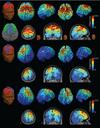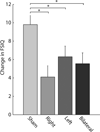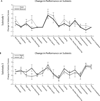Transcranial direct current stimulation (tDCS) of frontal cortex decreases performance on the WAIS-IV intelligence test
- PMID: 25934490
- PMCID: PMC4447535
- DOI: 10.1016/j.bbr.2015.04.031
Transcranial direct current stimulation (tDCS) of frontal cortex decreases performance on the WAIS-IV intelligence test
Abstract
Transcranial direct current stimulation (tDCS) modulates excitability of motor cortex. However, there is conflicting evidence about the efficacy of this non-invasive brain stimulation modality to modulate performance on cognitive tasks. Previous work has tested the effect of tDCS on specific facets of cognition and executive processing. However, no randomized, double-blind, sham-controlled study has looked at the effects of tDCS on a comprehensive battery of cognitive processes. The objective of this study was to test if tDCS had an effect on performance on a comprehensive assay of cognitive processes, a standardized intelligence quotient (IQ) test. The study consisted of two substudies and followed a double-blind, between-subjects, sham-controlled design. In total, 41 healthy adult participants were included in the final analysis. These participants completed the Wechsler Adult Intelligence Scale, Fourth Edition (WAIS-IV) as a baseline measure. At least one week later, participants in substudy 1 received either bilateral tDCS (anodes over both F4 and F3, cathode over Cz, 2 mA at each anode for 20 min) or active sham tDCS (2 mA for 40 s), and participants in substudy 2 received either right or left tDCS (anode over either F4 or F3, cathode over Cz, 2 mA for 20 min). In both studies, the WAIS-IV was immediately administered following stimulation to assess for performance differences induced by bilateral and unilateral tDCS. Compared to sham stimulation, right, left, and bilateral tDCS reduced improvement between sessions on Full Scale IQ and the Perceptual Reasoning Index. This demonstration that frontal tDCS selectively degraded improvement on specific metrics of the WAIS-IV raises important questions about the often proposed role of tDCS in cognitive enhancement.
Keywords: Brain stimulation; IQ; Intelligence; Perceptual reasoning; WAIS-IV; tDCS.
Copyright © 2015 Elsevier B.V. All rights reserved.
Figures







Similar articles
-
PsychotherapyPlus: augmentation of cognitive behavioral therapy (CBT) with prefrontal transcranial direct current stimulation (tDCS) in major depressive disorder-study design and methodology of a multicenter double-blind randomized placebo-controlled trial.Eur Arch Psychiatry Clin Neurosci. 2018 Dec;268(8):797-808. doi: 10.1007/s00406-017-0859-x. Epub 2017 Dec 6. Eur Arch Psychiatry Clin Neurosci. 2018. PMID: 29214483
-
Prefrontal versus motor cortex transcranial direct current stimulation (tDCS) effects on post-surgical opioid use.Brain Stimul. 2017 Nov-Dec;10(6):1096-1101. doi: 10.1016/j.brs.2017.09.006. Epub 2017 Sep 6. Brain Stimul. 2017. PMID: 28917592 Free PMC article. Clinical Trial.
-
Randomized, crossover, sham-controlled, double-blind study of transcranial direct current stimulation of left DLPFC on executive functions .Restor Neurol Neurosci. 2018;36(6):755-766. doi: 10.3233/RNN-180872. Restor Neurol Neurosci. 2018. PMID: 30412514 Clinical Trial.
-
Viability of tDCS in Military Environments for Performance Enhancement: A Systematic Review.Mil Med. 2020 Feb 13;185(1-2):e53-e60. doi: 10.1093/milmed/usz189. Mil Med. 2020. PMID: 31735955
-
Cultural Considerations in Intelligence Test Adaptations: a Critical Review of the WAIS-IV India and Its U.K. and U.S. Counterparts.Arch Clin Neuropsychol. 2024 Nov 22;39(8):1354-1362. doi: 10.1093/arclin/acae090. Arch Clin Neuropsychol. 2024. PMID: 39470385 Review.
Cited by
-
Transcranial electrical stimulation nomenclature.Brain Stimul. 2019 Nov-Dec;12(6):1349-1366. doi: 10.1016/j.brs.2019.07.010. Epub 2019 Jul 17. Brain Stimul. 2019. PMID: 31358456 Free PMC article. Review.
-
Novel Neuromodulation Techniques to Assess Interhemispheric Communication in Neural Injury and Neurodegenerative Diseases.Front Neural Circuits. 2017 Mar 9;11:15. doi: 10.3389/fncir.2017.00015. eCollection 2017. Front Neural Circuits. 2017. PMID: 28337129 Free PMC article. Review.
-
Phase Dependency of the Human Primary Motor Cortex and Cholinergic Inhibition Cancelation During Beta tACS.Cereb Cortex. 2016 Oct;26(10):3977-90. doi: 10.1093/cercor/bhw245. Epub 2016 Aug 13. Cereb Cortex. 2016. PMID: 27522077 Free PMC article.
-
Precision non-implantable neuromodulation therapies: a perspective for the depressed brain.Braz J Psychiatry. 2020 Aug;42(4):403-419. doi: 10.1590/1516-4446-2019-0741. Epub 2020 Mar 16. Braz J Psychiatry. 2020. PMID: 32187319 Free PMC article.
-
Anodal Transcranial Direct Current Stimulation Promotes Frontal Compensatory Mechanisms in Healthy Elderly Subjects.Front Aging Neurosci. 2017 Dec 18;9:420. doi: 10.3389/fnagi.2017.00420. eCollection 2017. Front Aging Neurosci. 2017. PMID: 29326582 Free PMC article.
References
-
- Prabhakaran V, Smith JA, Desmond JE, Glover GH, Gabrieli JD. Neural substrates of fluid reasoning: an fMRI study of neocortical activation during performance of the Raven’s Progressive Matrices Test. Cognitive psychology. 1997;33:43–63. - PubMed
-
- Esposito G, Kirkby BS, Van Horn JD, Ellmore TM, Berman KF. Context-dependent, neural system-specific neurophysiological concomitants of ageing: mapping PET correlates during cognitive activation. Brain : a journal of neurology. 1999;122(Pt 5):963–979. - PubMed
-
- Duncan J, Seitz RJ, Kolodny J, Bor D, Herzog H, Ahmed A, et al. A neural basis for general intelligence. Science. 2000;289:457–460. - PubMed
-
- Duncan J, Owen AM. Common regions of the human frontal lobe recruited by diverse cognitive demands. Trends in neurosciences. 2000;23:475–483. - PubMed
-
- Liu J, Zhang M, Jou J, Wu X, Li W, Qiu J. Neural bases of falsification in conditional proposition testing: evidence from an fMRI study. International journal of psychophysiology : official journal of the International Organization of Psychophysiology. 2012;85:249–256. - PubMed
Publication types
MeSH terms
Grants and funding
LinkOut - more resources
Full Text Sources
Other Literature Sources
Medical
Miscellaneous

